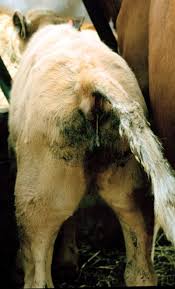Preventing Coccidiosis In Spring-Born Calves
13 February 2018Shortage of straw for bedding housed cattle is a real risk this year. One of the potential impacts could be an increase in cases of coccidiosis, particularly if we have a late spring and turnout is delayed.
The Disease
Coccidiosis affects calves from around three weeks of age and upwards, and can occur during housing or at pasture. Typically, affected animals develop a bloody scour, often accompanied by severe straining, and in some cases the scour will result in dehydration and death . However, a more insidious form of coccidiosis can occur resulting in reduced feed intake, poor growth rates and ill-thriven calves but with no diarrhoea. The disease is diagnosed by examination of dung or scour samples for the presence of oocysts (eggs) however care should be taken when interpreting the results of such examinations. Severely scouring calves may have very low numbers of oocysts in their dung, while apparently normal calves in the same group may be shedding large numbers of oocysts. It is therefore recommended to sample a number of calves in an affected group in order to maximise the chance of reaching a diagnosis.
Prevention
Coccidiosis can be prevented primarily through good hygiene and management practices. The reasons for this are:
- The disease is spread by contamination of feed and water troughs by the dung of infected calves. Therefore, feed and water troughs should be positioned so that faecal contamination is less likely. Removal of feed contaminated with dung is regarded as good practice.
- The oocysts in the dung need a moist, warm environment to become infective. Indoors, straw bedding which is damp and contaminated is an ideal environment for these oocysts, while wet areas around feed and water troughs outdoors carry the same risks. Disease surveillance data has demonstrated that outbreaks of coccidiosis peak in May, at the end of the housing period, when contamination levels are at their highest. There is another peak in autumn when the fields start to suffer from the wetter weather but the temperature is high enough to allow oocysts to become infective.
- Outbreaks of coccidiosis will often occur following a period of stress such as transport, castration, dehorning/disbudding or weaning. Carrying out these activities at a time when the environmental conditions are less able to support coccidial oocysts is recommended.
- Isolating any calves with suspect coccidiosis is essential, as an infected calf can rapidly spread the disease. Isolation also allows regular assessment of the calf’s hydration status so that rehydration therapy can be started promptly if required.
There are a small number of pharmaceutical products available to help in the fight against coccidiosis. Take time now to discuss the options with your vet as different strategies can be employed depending on your management practices.
Summary
Prevention of coccidiosis in spring-born beef calves is best achieved by:
- Good hygiene and management practices;
- Identification and isolation of affected calves (this may involve group sampling);
- Careful use of anti-coccidial pharmaceutical products.
David Gibson, david.gibson@sac.co.uk
Sign up to the FAS newsletter
Receive updates on news, events and publications from Scotland’s Farm Advisory Service

